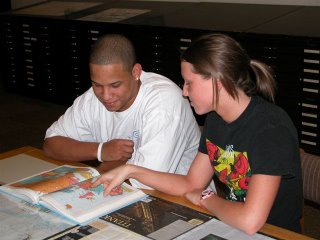
Classroom Experience Extends to Discovery of
the Geospatial Center and Map Collection
by Melissa S. Gentry, Map Collection Assistant
Imagine a gas explosion devastates downtown Muncie and, strangely, the only buildings to survive the blast were ones built before 1950. This horrible disaster seems unthinkable, but for students in an architecture class at Ball State University this emergency was actually part of a class project. Students visited the University Library’s Geospatial Center and Map Collection(GCMC) to research maps of downtown Muncie to determine which buildings would now be a part of this new, yet destroyed, landscape.
For many students, the University Libraries are a destination for research, learning, and friends. And for many students, the GCMC is where students go to research and learn about a
destination.
Classes of students ranging in age from elementary to elderly have visited the GCMC to utilize the extensive collection of maps, atlases, digital data, and GIS software. During the fall semester of 2005 and so far during the spring semester of 2006, dozens of classes have visited the GCMC to complement the learning environment in the classroom. For example, a class of sixth-grade students wanted to learn more about the different types of maps available and what types of information can be presented on maps and in atlases. These students were fascinated to learn about maps showing where diseases have spread across the globe, a map showing all the Major League Baseball stadiums, and especially the Titanic Reference Map. Three different classes of Landscape Architecture students visited the GCMC to learn about the resources available in preparation for a specific class project. Some students were preparing for a field trip to New York City while others were assigned a site to develop in Muncie. These students used various historic maps, street maps, atlases, aerial photography, and other data while working on their projects. The students working on the Muncie site checked out historical aerial photographs in five-year spans in order to focus on the changes in the city over time.
Other classes and instructors use the resources of the GCMC informally or individually for their classroom projects. Students in majors other than geography use the geographic resources available in the GCMC. Professors in Arabic, French, and German languages have borrowed maps for their classroom activities. A group of students studying anthropology once needed various types of data for an upcoming archaeological dig. Students who were studying sociology want to research the Amazon; Aquatic Biology thesis students need to look at topographic maps; students majoring in elementary and secondary education use maps and atlases for their lessons; many maps have been used as visual aids in a speech class; and Study Abroad students want to see where they are going. A cooking instructor at the Center for Vital Aging uses maps in her classes for the elderly to coordinate with the cuisine. Also, maps from the GCMC are featured on the WIPB Quiz Show on public television.
The GCMC also takes resources into the classroom for specific class needs. General GIS training sessions have been presented for students and faculty in English, Journalism, and Marketing classes. Students and Faculty in the Departments of Criminal Justice, History, and Environmental Management have also been exposed to GIS information during library instructional classes. Following their introduction to GIS principles, these students complete class projects using the geographic knowledge and skills they have gained. Many of these students then use the GIS lab in the GCMC to complete projects in other classes.
Classroom research and learning can be expanded with the resources of the University Libraries. The Geospatial Center and Map Collection is a great destination with a wealth of resources that can be used to enhance and elevate the classroom experience.

No comments:
Post a Comment